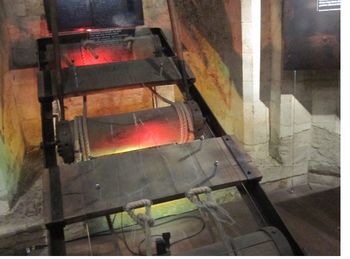The Tower Of London is one of the most popular tourist attractions in London with many sources of tourist information proudly declaring its heritage as a place where hundreds of years of history have taken place, royalty have walked and prisoners have been tortured. It is this last point that awakens the imagination and captures the interest of many of the tourists who visit this place. With its gruesome history including the beheading of Ann Boleyn and usage of torturous devices like the "Rack" and the "Scavenger's Daughter" – it is shamefully entertaining to imagine these times of torture and suffering.
Outside the Tower of London, they certainly take advantage of this more barbaric time in the history of the Tower with imagery and promotional materials – right up until you buy the ticket and actually walk inside. As you walk through the Tower, nearly every sign mentioning this history of torture takes great pains to point out that very few prisoners were ACTUALLY tortured here, despite the number of devices and legends of torture over the 16th and 17th centuries. It seems like a classic case of modern historians trying to rewrite their own history to avoid admitting that perhaps some of the ways of the past were not quite so regal or heroic as they have been written.
Instead, what if the Tower of London admitted its own history … one that at times was bloody and led to prisoners being tortured, but one that is also now over. Admitting your own failures is a tough thing to do, but sometimes avoiding an obvious truth can be worse. The Tower of London misses the mark and undermines its own credibility in the process. Are you unintentionally doing the same with your business?
Most of us are not so good at admitting and even publicizing our mistakes. If you can do it, however, you can create a much more powerful bond with your customers because they know what you have struggled with in order to get to the point that you are at today.
The Tower of London needs the context of the bloody time in its nearly thousand years of history to put today into context. Most businesses need this context as well. Standing apart for trying to project the perfect image is the obvious thing to do. Instead, if you could let your customers inside to know your biggest mistake and how it helped you to shape your business today, you could not only inspire your customers, but also give them a story to share with family and friends.
This post is republished from my original article on the Amex Open Forum website. It is part of "Small Business Friday" on this blog, where I share ideas and marketing techniques specifically to help small businesses stand out. To read more articles like this, visit the "Small Business Friday" category on this blog.
2 thoughts on "The Tower Of London's Big Marketing Mistake"
TRENDING CURRENTLY
- How MindValley Is Building the Next TED (Only More Useful) »
- My 500th Blog Post – A Big Thank You »
- What Does Chacha Mean To You? (The Power Of A Name) »
- Is “Sludge” a Real Customer Service Tactic to Avoid Irate Customers? »
- Manifesto For The Content Curator: The Next Big Social Media Job Of The Future ? »

I suspect that the signs inside may actually be more accurate. The Tower probably has a formal historical education mandate, and the signs inside will be held to the standards of accuracy of a museum. The Science Museum recently got into a little trouble for sensationalising some of its exhibits – good for marketing perhaps, but not fitting in this case its educational role.
I don’t think at all that marketing and education are incompatible – it’s entirely possible to successfully achieve both aims. But I think we need to remember that the Tower is not just a marketing or tourist operation, but needs to maintain a high standard of historical truth as well.
So it might not be a sense of shame that has led to these signs…but a desire for painstakingly accurate reporting! Maybe there really was very little torture and it’s the outside advertisements that are the misleading ones…
The tower of London is a very amazing spot to capture in that place.
It is not just that it entertain your eyes but will also gives you some informational background way back before.
https://www.sleeplessjade.com/